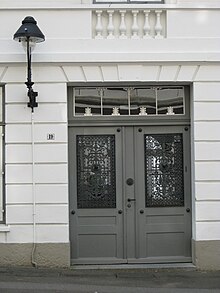Johann Daniel Jacobj
Johann Daniel Jacobj (* 1798 in Lübeck ; † 1847 there ) was an economically successful Lübeck merchant and art collector in the first half of the 19th century.
biography
Jacobj grew up as the son of the Lübeck merchant Daniel Jacobj in the Great Petersgrube in Lübeck's old town and visited the Katharineum . The house where he was born is no longer there. Jacobj had it demolished in 1825 and rebuilt in the classicist style by the architect Joseph Christian Lillie . With the modern house number 19, it is now part of the historic building complex of the music college and is a listed building.
After completing his commercial apprenticeship in Hamburg , he set off on his grand tour through almost all of Europe from 1821 , from which the travel description to his return to Lübeck in 1823 was almost completely in four handwritten volumes, with the exception of one further volume, probably lost, in the Archive of the Hanseatic City of Lübeck is preserved and documented in detail. Jacobj, who is interested in many things, uses the trip not only to gain useful business relationships, but also to engage intensively with art, culture and the world of women. In Rome he met his acquaintance, the Capitoline-born Theodor Rehbenitz , a brother-in-law of Friedrich Overbeck from Lübeck, who took him to and through the sights of Rome. Despite the letters of recommendation from Lübeck that were brought with him, the hoped-for portrait by Overbeck, who is currently working on the entry of Christ into Jerusalem for the Marienkirche in Lübeck, does not come about in the set time . Rehbenitz as Cicerone finally refers Jacobj to the Nazarene Carl Eggers . Before the Second World War, the portrait of the prospective businessman made by him in 1823 was initially purchased by the city of Lübeck as Overbeck's work. Today it hangs as a work by Carl Egger in the Behnhaus Museum .
When he returned to Lübeck in 1823, he took over his father's business and became a member of the Schonenfahrer corporation . After the French era, the city found itself in a decidedly restorative phase and suffered for decades from the burden of debt. The economic development of the time was recessive. The cosmopolitan and liberal Jacobj protested against this. Despite his great success as a businessman, who multiplied his fortune, he offended the ruling patriciate of the Hanseatic city and was soon seen as a downright troublemaker.
Jacobj attacked the traditional in an impartial and lasting manner. He succeeded in 1832 with his logical approach, for example to force the Senate to change an antiquated and unjust customs system that had actually already become impracticable according to the letter of the law. In 1843, for Lübeck standards, he overdrawns corruption in the Lübeck military , but the criminal prosecution by the city's lower court only comes to an end with his death.
The Lübeck lion of Christian Daniel Rauch , now before the Holsten Gate , he acquired in 1840 and introduced her to his home in the Great Petersgrube on. This earned him the nickname Daniel from the lion's den in Lübeck . Two more stone lions were erected around 1860 on his tomb, which is no longer in existence, in the Burgtorfriedhof . After 1961 they came to the Parchamsche Foundation and today they guard its mansion in Paddelügge.
In 1846, a year before his death, he had Alessandro Sanguinetti , brother of Rauch's favorite student Francesco Sanguinetti , make a marble bust for himself, which also came to the Behnhaus from the estate of his relative Olga Rodde .
literature
- Alken Bruns: Scenes from the travel book of the businessman Johann Daniel Jacobj. In: The memory of the Hanseatic city of Lübeck: Festschrift for Antjekathrin Graßmann on the 65th birthday. In connection with the Association for Lübeck History and Archeology and the Hanseatic History Association ed. by Rolf Hammel-Kiesow and Michael Hundt. Lübeck: Schmidt-Römhild 2005, pp. 199–208, ISBN 3-7950-5555-5
- Ilsabe von Bülow: Joseph Christian Lillie (1760-1827). Berlin 2008, p. 116 ff. ISBN 9783422066106
- Alken Bruns: Johann Daniel Jacobj in: Biographisches Lexikon für Schleswig-Holstein and Lübeck, Volume 12 Neumünster 2006, p. 225 ff., ISBN 3529025607
- Jan Zimmermann: Take the lions out of circulation! Restoration required - implementation desirable . In: Lübeckische Blätter 162 (1997), pp. 358-361.
Individual evidence
- ^ Name spelling according to Klaus Bernhard: Plastik in Lübeck - Documentation of Art in Public Space (1436–1985), Lübeck 1986, No. 7
- ↑ Lübeckisches Address Book 1798: Große Petersgrube No. 416 in the Marienquartier
- ↑ a b Bruns: Scenes from the travel book p. 199
- ^ Klaus J. Groth: World Heritage Lübeck - Listed Houses. Lübeck 1999, p. 216 ff., ISBN 3795012317
- ^ Hans Schröder: Overbeck acquisitions of the Behnhaus. In: Der Wagen 1939, pp. 142–145.
- ^ Antjekathrin Graßmann : Lübecker Geschichte , 2nd A. 1989, p. 579
- ↑ Bruns: Scenes from the travel book, pp. 207 ff.
- ^ Bruns: Scenes from the travel book, p. 208
- ^ Max Hasse : Catalog Behnhaus Lübeck 1969, p. 146 # 294 Portrait Johann Daniel Jacobj 1846. Marble, H 51, inscribed: A. Sanguinetti fee. 1846. Inv. No. 1941/428. From the estate of Olga Rodde.
| personal data | |
|---|---|
| SURNAME | Jacobj, Johann Daniel |
| BRIEF DESCRIPTION | Lübeck merchant and art collector |
| DATE OF BIRTH | 1798 |
| PLACE OF BIRTH | Lübeck |
| DATE OF DEATH | 1847 |
| Place of death | Lübeck |

